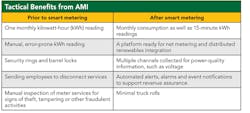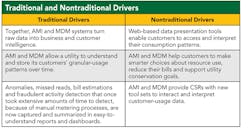Get Ready for Smart Grid
Founded in 1892, Braintree Electric Light Department (BELD) may be one of the oldest municipal electric utilities in the United States, but its strategy to embrace new technologies is far from dated. Because the ultimate goal of smart grid technology is to put customers first and ensure a stable supply of electricity well into the 21st century, BELD began a smart grid journey in 2010 that has challenged ageless metering processes, introduced new mechanics for revenue protection, and yielded a clear path toward quicker detection and restoration of outages.
BELD’s journey consisted of four main steps to implementing a successful smart grid solution. Based on the results of its journey, the utility gained a new appreciation for the changing dynamics of defining smart grid value and implementation strategies.
BELD started its smart metering implementation, using advanced metering infrastructure (AMI), in 2010 and completed installations in 2012. The selection and timing of AMI was a by-product of cross-utility preparation, collaboration and teamwork from the vendor community to understand both the current and modernized state of BELD. The utility’s board members had to understand the value of smart grid systems, the capabilities of BELD staff to execute selected projects, the short- and long-term goals, future systems and integration work, as well as how to connect with customers in new and exciting ways. BELD needed a plan.
Build a Plan
Working with SAIC, BELD began by developing a clear systems road map. The original cost-benefit analysis focused on obvious efficiency opportunities such as reduced meter reading expenses, more accurate meter reads, fewer truck rolls, efficient and rapid remote disconnect for non-paying and move-out customers, and faster power outage restoration. Staffing constraints and flexibility in project time lines enabled BELD to dive deep into database technologies, system capabilities and communications backhaul management strategies, and also allowed the utility to look forward at integration needs prior to the rollout of a meter data management (MDM) system or other smart grid solutions.
These important questions needed to be answered to establish a baseline and future goals of the project:
- When should smart metering be implemented and when should a MDM system be implemented?
- Where should distribution automation and advanced outage management systems occur in the smart grid time line?
- How should the utility address the impact on staff, and their job responsibilities, resulting from expanded functionality of smart grid systems?
- How will the utility ensure the right vendor selection to complement its forward-looking goals?
- BELD found the following tasks useful when outlining a smart grid implementation road map:
- Dive into existing system architectures, processes and team member capabilities. Document this information and leverage it when exploring the installation, integration or replacement of existing systems.
- Understand the capabilities of the investment. Timing and scheduling of a systems implementation in terms of business value will provide involved teams the flexibility to explore important and necessary integration points.
- Do not bite off more than the utility can handle. Develop a robust vendor proposal that addresses current and future smart grid integration needs of an AMI solution as well as the specific needs of the utility’s departments
- Invite multiple vendors on site to explore systems capabilities and see how they align with existing and forward-looking needs.
- Score vendor responses based on the ability to meet current and future needs.
- Collaborate on the negotiation/contract signage process.
Understand the System
This strategy for AMI then can be applied to other smart grid systems and solutions. BELD understood that implemented systems such as electric grid devices, telecommunications, and software and logical architecture would lead to additional leveraging opportunities for its smart grid
solution.
The implementation of smart grid hardware and software introduces new data, changes business processes, and requires collaboration and teamwork to ensure the best technologies are selected. At BELD, the implementation of AMI brought new, robust data sets, new methodologies to manage and mitigate theft detection, and revenue assurance, as well as new means to minimize the amount of customer premise visits.
Be Prepared to Learn
As BELD rolled out its smart grid implementation program, the utility was surprised to come across quantifiable value points not directly captured or underestimated in the original return-on-investment analysis. BELD learned the following from its smart grid implementation program:
- AMI empowers customer service representatives (CSRs) to handle customer questions on usage, power quality, billing, and the dynamics of supply and demand. This exposure to the intricacies of meter-to-cash processes and associated systems expanded the traditional role of CSRs, provided an exciting means to address customers concerns, and kept CSRs aligned with the leading edge of information and operational technologies.
- Truck rolls associated with nonpayment, power quality, high bill concerns and accuracy of meters were drastically reduced. BELD’s CSRs can now handle nearly all calls received by reviewing the customer data.
- Cross-utility collaboration is the key to success. BELD worked with its union team members to develop an installation plan that relied solely on BELD team members. This brought about new levels of trust, excitement in technology implementation and transparency to the forward-looking smart grid goals. It also allowed BELD to leverage the years of experience its team members had and deep system knowledge when installing meters.
- Attrition, retirement and staff augmentation are strategies to address changes in roles and management of AMI system needs. The rollout actually ended up enabling BELD to define some new roles and responsibilities for its staff, rather than having to explore layoffs or early-termination strategies.
Follow the Plan
Sticking to the road map is crucial. Nearing the completion of its AMI installations, BELD followed its smart grid road map and arrived at the MDM system implementation in late 2012, with a scheduled completion in late 2013. The team was able to leverage its developed collaboration techniques, project processes and business value exploration methodologies from the AMI project, and identified traditional and nontraditional drivers.
In identifying traditional and nontraditional business drivers, BELD soon realized that one was especially true to its mission statement of providing a competent, well-trained staff dedicated to providing safe, reliable, economical energy and related services for customers, and responsive public service for the community. And the driver is that AMI and MDM provide CSRs with new tool sets to interact and interpret customer usage data.
Before AMI and MDM systems, an energy specialist was sent out to the customer premise for every customer inquiry. Part of this job responsibility was to build relationships with customers who, in many cases, had forgotten why a high bill might actually have been warranted. Now, with smart grid, CSRs can leverage the associated metering data sets and solve customer’s questions right over the phone. BELD now can solve a majority of its customer’s questions with no delays or additional truck rolls.
Although it is difficult to attach a dollar value to these benefits, the improvements in reliability and customer perception from these additional applications may be far greater than originally imagined. By presenting consumption data to customers on a near-real-time basis, a customer usage web portal, powered by data from the MDM system, creates a powerful connection between energy consumed and money spent. BELD has found customers want to use this tool, and the utility is using the capability to promote its energy-savings programs to target audiences.
Meet the Goals
Smart grid technologies are key enablers to realizing efficiencies, restoring power more quickly, and delivering power on a safe and resilient electric grid. By spending the upfront time needed to understand its current and future goals, BELD uniquely positioned itself on a road map toward smart grid success.
Removing the historically siloed nature of utility organizations allowed BELD to include team members from metering, engineering, field installations, and both union and management on its smart grid journey. By engaging cross-discipline team members early and often, BELD realized the connected grid vision of involving both its internal teams and customers in its smart grid vision.
Joe Morley([email protected]) is the engineering and operations manager at Braintree Electric Light Department. Morley has more than 43 years of electric utility engineering and management experience, and was directly involved in leading strategy, implementation and support of BELD’s advanced metering infrastructure and meter data management systems.
Gail Cohen ([email protected]) is the manager of support services at Braintree Electric Light Department. With 28 years of utility experience. she is responsible for the daily management of customer-facing personnel and associated management systems. She is directly credited with exploring and defining the value of customer web presentment as well as leveraging advanced systems and data to support customer-related issues.
Zac Canders ([email protected]) is a program manager within SAIC’s emerging technology division. He has extensive experience leading the design, development and implementation of smart grid solutions at the nation’s largest investor-owned utilities and municipalities, where he directly managed advanced metering infrastructure, meter data management, enterprise resource planning and grid optimization projects.
Companies mentioned:
Braintree Electric Light Department| www.beld.com
SAIC| www.saic.com







